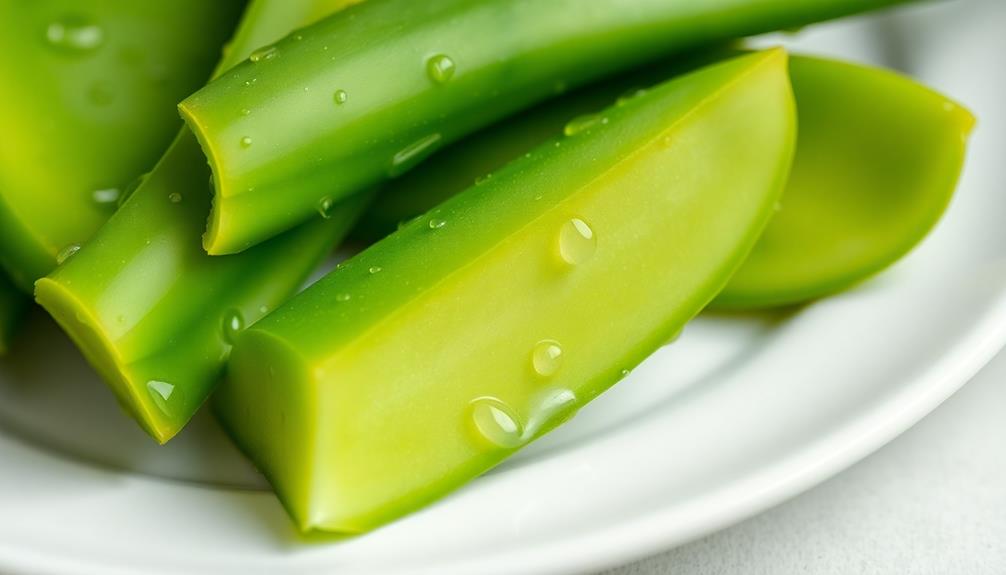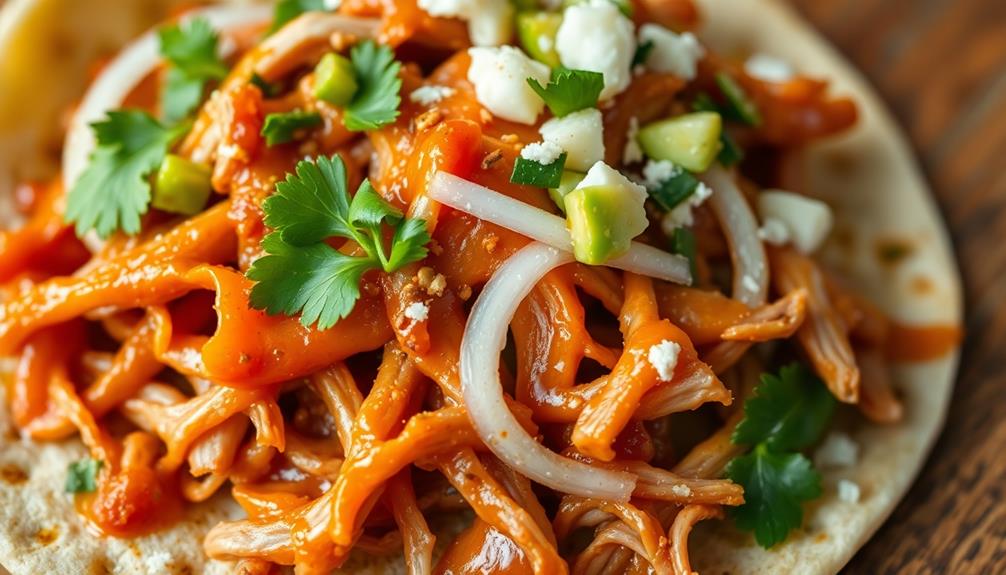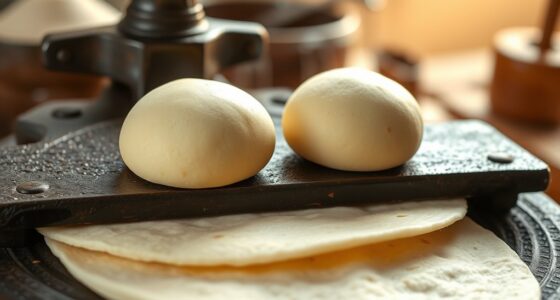You're in for a real treat! Nopales are the flat, green pads of the prickly pear cactus, and they've been a staple in ancient Mesoamerican cuisines for centuries. These unique veggies offer a tasty, slightly tart flavor that complements all sorts of dishes. They're packed with nutrients like fiber, vitamins, and antioxidants too. You can enjoy nopales in salads, tacos, omelets, and even desserts! To prepare them, you'll need to carefully clean and remove the spines, then slice and sauté them with onions and seasonings. This versatile ingredient is sure to delight your taste buds – let's dive in and discover more!
Key Takeaways
- Nopales are flat pads from the prickly pear cactus, originating in ancient Mesoamerican civilizations and now enjoyed globally in various dishes.
- Nopales are nutrient-rich, providing dietary fiber, vitamins, and antioxidants, making them a healthy and weight-friendly food choice.
- Nopales have a mild, slightly tart flavor that complements a variety of ingredients and can be used in salads, tacos, stews, and more.
- Preparing nopales involves cleaning, removing spines, and cooking them through methods like sautéing, grilling, or boiling to enhance their texture and flavor.
- Nopales offer versatile culinary possibilities, from traditional Mexican dishes to innovative uses in dips, sauces, breakfast items, and international cuisines.
History
The history of nopales, or prickly pear cactus, can be traced back to ancient Mesoamerican civilizations. These tough, spiny plants were an important food and medicine for the Aztecs, Maya, and other indigenous groups. They'd harvest the flat pads, called nopales, and use them in all kinds of delicious dishes.
Over time, the Spanish conquistadors brought nopales to Europe, where they quickly became popular. Today, nopales are enjoyed around the world, from Mexico to the Middle East. You can find them in salads, tacos, and even smoothies!
The cactus pads are packed with nutrients like vitamin C, fiber, and antioxidants. Plus, they've a unique, slightly tangy flavor that people love.
Whether you're trying nopales for the first time or you're a lifelong fan, there's so much to discover about the history and uses of this amazing plant. From ancient civilizations to modern kitchens, nopales have left their mark on cultures around the globe.
Recipe
Nopales, the juicy and versatile pads of the prickly pear cactus, have long been a staple in Mexican cuisine. These nutritious greens, packed with fiber, vitamins, and minerals, make for a delightful addition to a variety of dishes. In this recipe, we'll explore a classic way to prepare nopales, highlighting their unique flavor and texture.
Nopales can be enjoyed in many forms, from salads and tacos to stews and omelets. Their mild, slightly tangy taste pairs well with a range of ingredients, making them a versatile choice for the home cook. With a few simple steps, you can unlock the full potential of these remarkable cactus pads and create a dish that's both flavorful and nutritious.
- 1 lb fresh nopales, cleaned and diced
- 1 onion, diced
- 2 tomatoes, diced
- 2 cloves garlic, minced
- 1 jalapeño, seeded and minced (optional)
- 2 tbsp olive oil
- Salt and pepper to taste
- Chopped cilantro for garnish (optional)
In a large skillet, heat the olive oil over medium heat. Add the diced onion and sauté until translucent, about 5 minutes. Stir in the minced garlic and jalapeño (if using) and cook for 1-2 minutes, until fragrant.
Add the diced nopales and tomatoes, and season with salt and pepper. Cook, stirring occasionally, until the nopales are tender and the tomatoes have softened, about 10-15 minutes. Adjust seasoning to taste.
When preparing nopales, it's important to remove the small, sharp spines on the pads before cooking. This can be done by gently scraping them off with a knife or by using a vegetable peeler.
Additionally, nopales can release a slightly slimy texture when cooked, so it's recommended to boil them briefly before sautéing to reduce this effect. Serve the cooked nopales warm, garnished with fresh chopped cilantro if desired. Enjoy this nutritious and flavorful dish as a side or as part of a larger Mexican-inspired meal.
Cooking Steps
Rinse and pat dry those fresh nopales (prickly pear pads) to get rid of any dirt.
Then, carefully remove the tiny spines using a knife or your fingers.
Next, slice the nopales into long, thin strips – they'll sizzle up nicely in the pan!
Sauté the nopales with some onions, and don't forget to add your favorite seasonings for extra flavor.
Step 1. Rinse and Pat Dry the Nopales
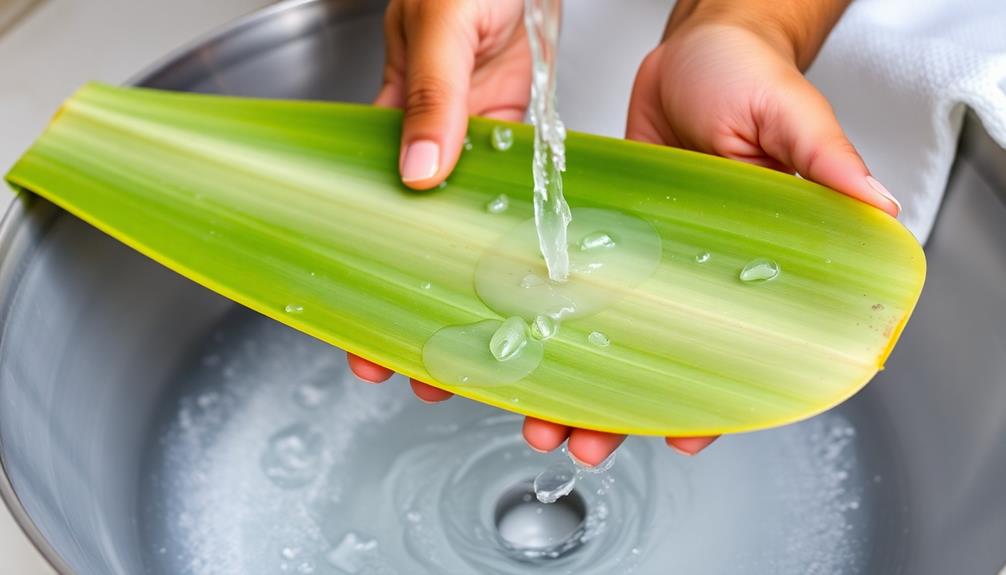
After harvesting the nopales, you'll want to rinse them thoroughly under cool running water. This will help remove any dirt, debris, or prickly glochids (those tiny spines) that may be clinging to the surface.
Be sure to gently rub each pad with your fingers to dislodge any stubborn particles.
Once they're nicely cleaned, use a paper towel or clean kitchen towel to pat the nopales dry. You don't want any excess moisture, as that can cause them to become slimy during cooking.
Gently blot the pads until they feel dry to the touch.
Now that your nopales are prepped and ready, you can move on to the next step – cutting them into your desired shapes and sizes!
Whether you plan to sauté, grill, or add them to a salad, properly rinsing and drying the nopales is an important first step to ensure they turn out perfectly tender and delicious.
Step 2. Remove Spines
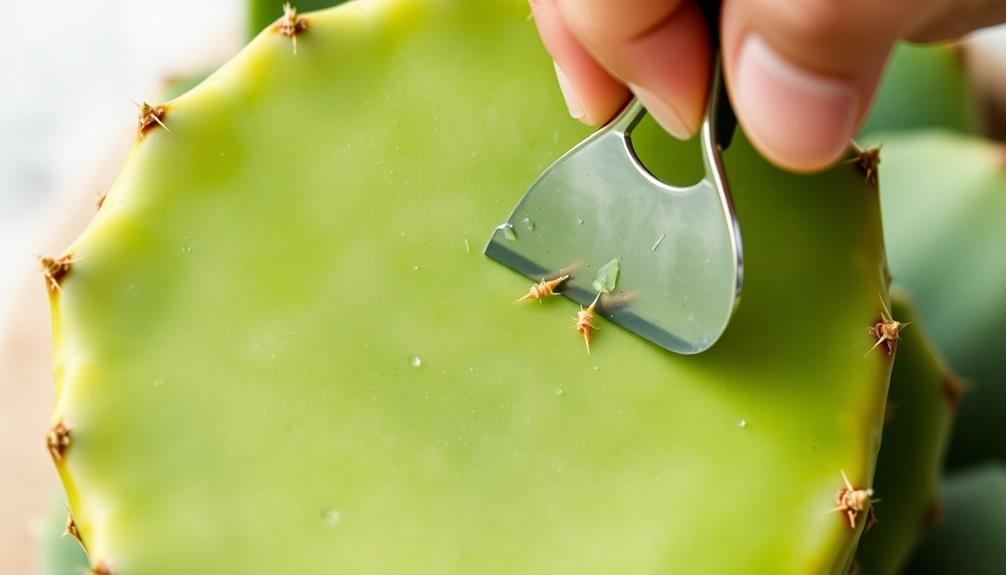
With the nopales now clean and dry, you'll want to tackle removing those pesky spines. Using a sharp knife, carefully slice off the edges of the nopales, making sure to remove all the little spines. Don't worry if some of the green skin comes off too – you want to get rid of those prickly bits!
As you work, keep an eye out for any remaining spines and use the knife to scrape them away. It might take a bit of elbow grease, but your efforts will be rewarded with smooth, spine-free nopales, perfect for cooking.
Once the edges are taken care of, flip the nopales over and do the same thing to the other side. Run your fingers over the surface to check for any stray spines, and use the knife to gently scrape them off.
With a little patience and attention to detail, you'll have nopales that are ready to be chopped, grilled, or added to your favorite dishes – no pricks in sight!
Step 3. Slice Nopales Into Strips

Having removed the spines, slice the nopales into thin strips. This is the fun part, where you get to transform those prickly pads into delicious strips ready for cooking.
Grab a sharp knife and carefully run it across the nopales, slicing them into long, thin strips. Don't worry if they're not perfectly uniform – the imperfections will add to the rustic charm!
As you slice, you'll notice the nopales release a slightly sticky, gooey substance. This is completely normal and just part of their unique texture. Embrace it!
The strips will be ready for sautéing, frying, or adding to your favorite dishes. You can even eat them raw in salads for a crunchy, tangy boost of flavor.
Once you've sliced all the nopales, give them a gentle rinse to remove any remaining spines or debris.
Then, they're ready to be cooked up into delicious Mexican-inspired meals. Get ready to wow your friends and family with your nopales-slicing skills!
Step 4. Sauté Nopales With Onions

Now that you've sliced the nopales into thin strips, it's time to sauté them with onions! This step is going to make your nopales even more delicious.
First, grab a large skillet and heat it over medium-high heat. Add a couple tablespoons of oil – you can use olive oil, vegetable oil, or even some butter for extra flavor.
Once the oil is hot, toss in the sliced nopales and onions. Stir them around so they get coated in the hot oil.
Keep sautéing the nopales and onions for about 5-7 minutes, stirring occasionally, until they start to soften and get a little golden brown on the edges.
You'll start to smell the wonderful aroma as the nopales and onions cook together. Mmm!
When they're nice and tender, you can season them with a sprinkle of salt and pepper. Give everything one last good stir to combine all the flavors.
Now your nopales are ready to enjoy – they'll be soft, slightly crunchy, and full of savory goodness!
Step 5. Add Seasoning

After the nopales and onions have sautéed until tender, it's time to season them. Grab a pinch of salt and a dash of pepper – these classic seasonings will bring out the natural flavors of the nopales.
Feel free to experiment with other spices too, like a sprinkle of cumin or a sprinkle of chili powder for a little kick.
Stir the seasonings in gently, making sure they're evenly distributed. Can you smell the aroma starting to fill the air? The nopales will soak up all those wonderful flavors, becoming even more delicious. Now, it’s time to add the cooked nopales to the traditional sopes recipe. These tender cactus paddles will add a unique texture and taste to the dish. Once they’re mixed in with the other ingredients, your traditional sopes will be ready to serve and enjoy with your favorite toppings.
Don't be afraid to add a little more seasoning if you want an extra punch of taste.
With the perfect blend of seasonings, your sautéed nopales are ready to enjoy. Whether you're serving them as a side dish or adding them to your favorite recipes, these nopales are sure to be a hit.
Get ready for some serious flavor power!
Final Thoughts
Nopales, the humble yet versatile cactus, have undoubtedly captivated the culinary world with their unique flavor and nutritional prowess. As you've discovered, these incredible plants can be transformed into an array of delectable dishes, from vibrant salads to hearty stews.
The journey of exploring nopales has been a delightful one, filled with new discoveries and the joy of experimenting in the kitchen.
Looking ahead, the possibilities with nopales are endless. Perhaps you'll venture into creating a zesty nopal-based salsa or a creamy nopal-infused dip to share with friends and family.
Or maybe you'll find yourself incorporating nopales into a comforting casserole or a flavorful quesadilla.
Wherever your culinary adventures take you, remember that nopales aren't only a nutritional powerhouse but also a versatile ingredient that can elevate any meal.
Frequently Asked Questions
What Are the Health Benefits of Consuming Nopales?
Consuming this vegetable can provide you with numerous health benefits. It's rich in fiber, vitamins, and antioxidants, which can help lower cholesterol, regulate blood sugar, and support overall digestive and immune system health.
How Can I Incorporate Nopales Into My Vegetarian Diet?
To incorporate nopales into your vegetarian diet, you can add them to soups, stir-fries, tacos, or omelets. You can also grill or sauté them as a side dish. Get creative and enjoy the unique texture and flavor of this versatile vegetable.
Where Can I Purchase Fresh Nopales Near Me?
To find fresh nopales near you, check your local Hispanic or Latin American grocery stores. You can also try Mexican or international markets in your area. Many supermarkets may carry them as well, especially in regions with a significant Hispanic population.
How Do I Store and Preserve Nopales for Later Use?
To store and preserve fresh produce for later use, you can refrigerate it, freeze it, or pickle it. The best method depends on how you plan to use the item in the future.
Are There Any Precautions I Should Take When Handling Nopales?
When handling nopales, you'll want to take some precautions. They contain tiny glochids or spines that can prick your skin, so be sure to wear gloves and handle them carefully. Additionally, you may want to flame the nopales briefly to remove any remaining spines.
